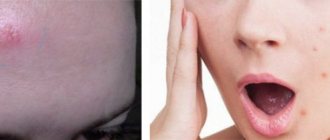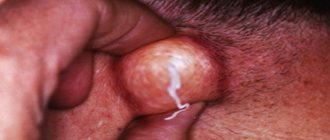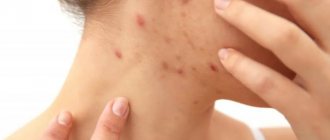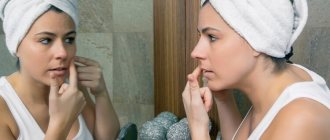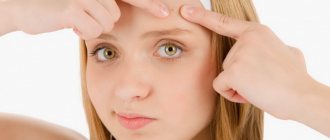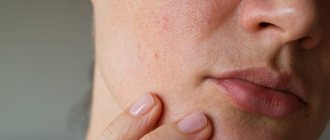- Pimples without pus on the face: causes
- Allergic reactions and acne without pus
- Papules and red pimples without pus
- Pustules and large pimples without pus
- Subcutaneous internal and painful pimples without pus
- Pimples without pus on the face and body: treatment
A pimple is a small pustule or papule A pimple develops when oil glands or pores become clogged and infected, resulting in swollen red lesions filled with pus Also known as spots or zits, pimples are part of acne They most likely occur during puberty, but they can appear at any age.
During puberty, hormonal production changes. This can lead to the fusion of the sebaceous glands located at the base of the hair follicles. As a result, acne is most common during adolescence and during menstruation for women.
Acne most often affects the face, back, chest and shoulders. This is because these areas of the skin have many sebaceous glands.
Pimples without pus on the face: causes
Rosacea, commonly mistaken for acne, is a skin condition that causes pimples without pus on the central part of the face. But unlike acne, which typically features whiteheads and pimples on the face and back, rosacea is often associated with facial redness and painful bleeding. eyes.
And while acne and rosacea have a genetic link, acne is usually caused by hormonal stimulation and bacteria. On the other hand, rosacea is usually caused by extreme temperatures, diet changes, and stress. The condition is also often an inherited skin condition.
Why is it important to treat acne?
At first glance, it seems that acne is a purely skin disease. The classic development scenario is as follows: excess synthesis of subcutaneous fat, accumulation of keratinized cells - blockage of the sebaceous glands, inflammation of the hair follicle - pimple. In fact, this is an external manifestation of internal problems.
Skin rashes serve as an SOS signal for the body. Pimples and their localization are a kind of messenger through which information about organ problems is transmitted. A special guide map “Types of acne and what they mean” has been compiled. This is a kind of projection of internal organs onto areas of the face:
- forehead - small intestine;
- eyelids and area around the eyes - kidneys;
- temporal region – gallbladder;
- middle third of the face, cheekbones – stomach;
- chin – pelvic organs;
- nose – pancreas;
- lower third of the face, lower jaw – lungs. i>
When acne is detected on the face and body, several reasons are considered:
- Imbalance of sex hormones. An increase in the concentration of the male hormone (testosterone) leads to hypersecretion of the sebaceous glands and hyperproduction of sebum. To confirm, a test for sex hormones is taken, and a consultation is held with a gynecologist to exclude diseases of the pelvic organs.
- Liver diseases. This “filter” of the body can become “clogged” during cleansing of toxins from the blood. A similar failure is reflected on the skin. You can check your assumptions by donating blood for biochemistry.
- Digestive problems. Impaired intestinal motility and peristalsis, frequent constipation contribute to intoxication and the appearance of acne. There is a reason to visit a gastroenterologist and get tested for dysbacteriosis.
- Infections. Streptococci and staphylococci provoke acne. If pus is present along with serous fluid, a bacterial culture is done and antibacterial treatment is prescribed.
- Weak immunity. Often ARVI/ARI are accompanied by purulent rashes.
- Allergy. A spontaneous rash may be the result of an allergic reaction. To prevent it from recurring in the future, it is necessary to identify the factor causing hypersensitivity. To do this, allergy tests are performed.
Allergic reactions and acne without pus
Poll: When did your acne appear? (Number of votes: 4295)
I've been suffering all my life
It's been a couple of years now
About a few months
Recently
To vote, click on the desired answer. results
Allergic reactions can come in many forms, so it's not surprising that some skin irritations can mimic breakouts. However, the key difference between acne and allergic skin reactions usually manifests itself in the case of allergies as intense itching, which is accompanied by red scaly patches and small pimples without pus.
An allergic reaction tends to be itchy, but acne and regular pimples are not. Acne can actually be painful, especially if you have large cysts. “If you constantly have allergic reactions, be sure to see a doctor.”
What is inflammatory acne or cystic acne, and how is it caused? When the pores are clogged and your immune system responds by sending white blood cells to fight the infection, the surrounding area becomes red and swollen or inflamed. This is called inflammatory acne.
Inflammatory acne occurs as a result of a break in the wall of a hair follicle or pore, leaking bacteria and oil into the surrounding skin. The closer to the surface of the skin these events occur, the smaller and smaller the breakout will be. If the break occurs deep inside the pore, you may experience a cyst - a large, hard, deep inside the skin Inflammatory acne is often throbbing and painful as blood flow increases to the area delivering white blood cells to contain and fight the infection.
There are different types of inflammatory acne depending on the size, redness, tenderness and scarring potential. Stopproblem camouflage foundation, which in addition to camouflage also treats acne on the face!
Subcutaneous internal and painful pimples without pus
Large, deep and painful bumps, blackheads and cysts fill initially with blood before filling with pus. They can linger beneath the surface for weeks or even months and can eventually harden. They can also leave deep scars and welts after they disappear.
Nodules are larger than normal pimples without pus, larger than pustules and papules, and initially form in the deeper channels of the skin. They are sensitive to the touch and can be quite painful. They develop when subcutaneous oil and bacteria penetrate deep into the pores, infecting adjacent follicles. Nodules. can harden into deep cysts and can leave deep scars on many levels and layers of the skin.
Cystic nodular acne is the most severe form of acne, which can be found both without pus and with its presence. Cystic acne can often lead to the formation of scars after it heals. Such acne is also most common in teenagers and young adults under 23 years of age. Cystic acne or any form of cicatricial acne requires immediate attention from a dermatologist. Your doctor will have the best solution for treating nodular acne.
Pimples without pus on the face and body: treatment
There are quite a large number of both medications and home remedies for acne treatment.
Toothpaste for acne
Toothpaste is quite effective for skin whitening and quick treatment of skin pimple, especially when applying white paste to the form of pimples without pus on the face.
Read more about the instructions for using toothpaste and the effectiveness of the treatment result in the next article!
Baking soda
Combine a small amount of baking soda with some water and apply it directly to your pimple using a cotton pad. The effect of using this product is the same as toothpaste; the difference between these products is only a slightly less sticky consistency and less minty smell!
Salicylovo - zinc paste
A unique acne remedy, containing two such powerful components of salicylin and zinc paste, can have a powerful effect on getting rid of acne on the skin of the body or face, as well as remove any traces after getting rid of them on the face.
Read more about the capabilities of Salicylic-zinc paste!
Erythromycin ointment
To treat acne without pus, use Erythromycin ointment, which is an antibiotic anti-inflammatory agent that quickly relieves acne on the face.
Use face masks for acne
Use one of the homemade face mask recipes you can find here on your face for acne. Such masks will pull out the cyst from inside the pimple and reduce its size significantly.
Tea tree oil
Treat your skin with tea tree oil. Tea tree oil is a popular and effective natural remedy for treating acne. Tea tree oil provides antimicrobial and anti-inflammatory activity. This means it can help reduce the swelling of your pimple trapped under the skin, as well as fight the bacteria that causes these breakouts to appear on your face.
Mix one drop of tea tree oil with nine drops of water Instead of water, you can dilute tea tree oil with an oil such as olive or mineral oil for better effect You can also dilute it with aloe vera gel Soak a cotton swab or cotton swab in tea tree oil Apply it on a pimple Wait for 10 minutes, then wash your face with warm water. You can resort to this procedure three times a day.
Make sure you don't get tea tree oil on your eye area because it can cause irritation.
Before applying tea tree oil to a pimple, test your skin's sensitivity to this product on a small area of skin Apply one drop of tea tree oil to your wrist and wait for about 15 minutes If you do not see any negative reactions, then you can safely use this product on your face from acne.
Types of acne and methods of treatment
The word “pimple” is a collective term that is popularly used to describe the entire spectrum of dermatological imperfections. In medicine, the following types of acne on the face are distinguished:
Comedo
This is what a future purulent pimple arises from. Hair follicles (pores) become clogged with sebum, dead cells, impurities and/or cosmetics. Further development of the process is possible according to two scenarios, according to which two types are distinguished.
Closed comedones (whiteheads / milia / millet) - resemble dense, white, protruding balls (1-2 mm in diameter), covered with a thin layer of epidermis. Because of them, the terrain becomes lumpy. The contents of the pore are localized deeply and are blocked from the external environment. Therefore, the color of sebum remains yellowish-white, for which they are also called wen.
Characteristic for combination and oily skin types. There is no pain or itching from them. Inflammation occurs when tissues become infected. The result is scars, scars.
Treatment. Various types of peeling are suitable: mechanical, chemical, vacuum, ultrasonic. For care, you should choose sebum-regulating products (masks, gels, creams).
Open comedones (blackheads) - unlike whiteheads, are not covered with a layer of keratinized cells. The pores are open, and the sebaceous plug is exposed to air and oxidized by oxygen. Therefore, the fat darkens, becoming black.
Treatment. First of all, proper care taking into account your skin type, regular chemical peels and other exfoliating methods (clay masks, warming masks, gommage, scrubs, rolls and film masks).
Important! All skin care products and decorative cosmetics must be marked “non-comedogenic.”
When an infection enters a comedone, two types of red pimples are formed: papules and pustules.
Papule
This is the name of a full-fledged pimple in the form of a lump, tubercle or ball. These are monochromatic formations, the color of which varies from red to bluish. During palpation they turn pale, turn white due to compression of the vessels, and then return to their original color. When pressing, severe pain is felt - a sign of inflammation. There is pus inside the papule, the adjacent skin is noticeably swollen. If they form in the upper layers of the skin, they dissolve without a trace. When deep-seated, this type of acne leaves behind scars.
Treatment. You won’t be able to get rid of them on your own and it’s not worth it, since the purulent focus is located deep in the dermis. When squeezed out, the infection can spread to healthy areas, as well as swelling, and even sepsis is possible. The dermatologist will select combined methods: reviewing the diet, giving up certain types of cosmetics, and the correct selection of skin care products. The dermatologist will select acne spot treatments and drying lotions. They should contain components such as benzoyl peroxide, salicylic acid and zinc.
Pustule
Such a pimple arises either on its own or from a papule. In contrast to the latter, it resembles a highly swollen ball, which at the base has a red, inflamed border and a head with liquid or white/yellow pus in the center. This is the result of the proliferation of bacteria - streptococci, staphylococci - in the pores. Once ripe, the pustules burst. The resulting wound makes the human body vulnerable to the penetration of new bacteria. They cause great discomfort to their owner, as they are painful even at rest. In addition, scars remain as a memory of them.
Treatment. If the epithelium is prone to forming pustules, it is worth choosing sebum-regulating creams and serums as care products. Pharmaceutical drying and anti-inflammatory drugs based on alcohol and salicylic acid are effective for treatment. Iodine also does a good job.
This is the name of a severe and painful form of acne. They look like several papules and pustules connected to each other by fistulous ducts deep in the dermis. The cause is hormonal changes, which is typical for adolescents, but also occurs in adults. If squeezed out, they spread under the skin and cause widespread inflammation. After healing, keloid scars form.
Treatment. It begins with a consultation with a dermatologist and a hormone test. Sometimes areas of inflammation are injected with cortisone to stop the inflammatory process. Cold compresses help slow down the spread of infection. It is important to maintain cleanliness and promptly exfoliate the stratum corneum using chemical peeling. In advanced cases, creams and serums with vitamin A are used.


